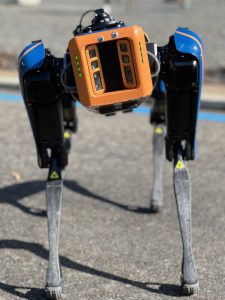An electricity distributor in South Australia trained a mobile robot called Spot through reinforcement learning, priming its workforce to incorporate generative AI into everyday operations.
When SA Power Networks procured the mobile robot Spot in 2020, the organisation was looking to explore how machines could equip its workforce with “superpowers”.
At the time, project lead Muen Chen, Data and Decision Science Lead at SA Power Networks, was working closely with the asset management team that collects data on a range of electricity distribution assets including familiar poles, transformers, powerlines, cable joints and insulators.
Data collection methods include photographs, thermal inspections and light detection and ranging – all processes the company was seeking to automate.
Chen likens creating automated solutions to photographic digitisation.
“Previously, you needed to work out how to take a picture using exposure settings, whereas nowadays, cameras are basically fully automated,” he said.
With a robot like Spot in tow, the next step was automating a camera to take pictures.
“Robots enable people to apply their knowledge in the field,” said Chen. “The workforce is trained to look for defects and unusual things we can’t get robots to do yet, but with the help of robotics, they can delegate the basic data collection tasks to a fully automated platform.”
Training Spot
When coaching Spot, the SA Power Networks team used reinforcement learning, which involves optimising its behaviour towards a reward.
“The idea with Spot was, if it knows how to go straight to a utility pole and take a picture, it gets a bigger reward,” said Chen. “But if Spot meanders around, taking a picture without a pole, it gets less of a reward.”

With SA Power Networks never having applied a reinforcement learning algorithm in the business before, cross-departmental collaboration was crucial.
Chen combined his knowledge with that of colleagues Michaela Matthews, an Innovation Graduate with a background in mathematical sciences, and former SA Power Networks Machine Learning Engineer Deon Mai, to nut out a solution.
“To understand reinforcement learning, which is deep Python code combined with statistics concepts, we watched OpenAI’s lecture series together,” said Chen.
“Michaela helped me understand what certain formulas do and Deon explained how it’s reflected in Python.”
Establishing an environment where everyone is open to asking questions is the key to success with reinforcement learning.
“It’s all about encouraging curiosity. There’s no wrong question, which is a really important mindset to have when experimenting with a brand new technology like this,” he said.
Introducing Spot to the workforce
With Spot stationed at the robotics lab in the SA Power Networks Asset Access Training Building, there have been countless engagements with different areas of the business.
“Different groups of tradespersons and engineers were doing training every day we were out there,” said Chen.
Along with on-the-field data collection, Spot was also designed to be used as a testbed to trial other payloads, building on ideas for different varieties and combinations that sprouted from the training sessions.
“Once people saw what Spot could do with the camera, they would ask, ‘What if we mount this on the back?’ or ‘What if we get it to go into the substation?’” said Chen.
The next steps for AI integration
While Spot is capable of taking photos of in-the-field assets such as electricity poles, there’s not a lot of context that comes with the imagery at this stage.
“We want to be able to create an intelligent platform so we can view the data as well,” said Chen.
Rather than the workforce knowing exactly how to navigate the system, the system itself could be proactive in helping the user understand how to get the right information.
“We’re inundated with data; there’s more of it every day,” said Chen. “So we want to cut out what’s not useful, and get the system to assist the user in finding exactly what they need.”
These days, Chen is more focused on how to deploy ChatGPT in the business. But Spot has helped to improve understanding about and drive the conversation around AI immeasurably.
“We got Spot not just to demonstrate that the technology works, but to show people that South Australia can be just as on top of the latest technology as a startup in Silicon Valley,” he said. “It’s about creating awareness and understanding how AI can be used.”
For now, Spot will remain tucked away at the robotics lab until it can be combined with generative AI.
“I’m keeping an eye on some researchers out there trying to use large language models with robots,” said Chen.
Giving robots a verbal command they can interpret and translate into action is something Chen predicts we’ll see in the not-too-distant future.
“At the end of the day, AI and robotics are all about helping people by reducing safety risks and improving productivity,” he said.
From Chen’s point of view, where AI is concerned, everyone is a team leader – whether fresh out of university or commencing an apprenticeship.
“AI will be following your commands, so you have to develop leadership and soft skills around communication very early in your career,” he said.
“There’s a lot of things you can leverage with AI, making you 10 times more productive than someone who doesn’t have these skills.”